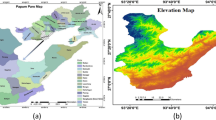Abstract
In this study, fuzzy AHP method is used for extracting the water quality indicators based on the Schuler standard and World Health Organization (WHO) guidelines during a 20-year period. For this purpose, the best fit of the zoning model was performed. Furthermore, by comparing the standard errors, the continuous Raster layer was extracted from the important parameters used in generating the qualitative potential assessment index. The classified layer was generated by integrating continuous layers in the GIS environment and with the use of Python programming. The similarity of the outputs of both methods indicates the presence of large sections of aquifers in the middle and southwestern regions of Iran in the “temporarily drinkable” and “bad” classes. The calculations showed that the majority of aquifers that were located in the “inappropriate” class during the first 10 years fell to less valuable class types. Based on the results of the model, there is a direct correlation between the drop in water resources and the decline in the quality indices. In addition, in the Urmia and Bushehr coastal aquifers, due to excessive water withdrawal and salty water penetration, the quality of the table water is in critical condition. Based on the results of the research, the aquifers in the range of Zagros and Alborz mountains show the least change in water quality. The reason for this is the depth of the aquifer and the ability to recharge it.





















Similar content being viewed by others
References
Amineh ZBA, Hashemian SJA-D, Magholi A (2017) Integrating spatial multi criteria decision making (SMCDM) with geographic information systems (GIS) for delineation of the most suitable areas for aquifer storage and recovery (ASR). J Hydrol 551:577–595
Banerjee P, Singh V, Chatttopadhyay K, Chandra P, Singh B (2011) Artificial neural network model as a potential alternative for groundwater salinity forecasting. J Hydrol 398:212–220
Bertolini M, Braglia M, Carmignani G (2006) Application of the AHP methodology in making a proposal for a public work contract. Int J Proj Manag 24:422–430
Eberhard F, Hamawand I (2017) Selective electrodialysis for copper removal from brackish water and coal seam gas water. Int J Environ Res 11:1–11
Gutmann E, Pruitt T, Clark MP, Brekke L, Arnold JR, Raff DA, Rasmussen RM (2014) An intercomparison of statistical downscaling methods used for water resource assessments in the United States. Water Resour Res 50:7167–7186
Hosseini-Moghari S-M, Ebrahimi K, Azarnivand A (2015) Groundwater quality assessment with respect to fuzzy water quality index (FWQI): an application of expert systems in environmental monitoring. Environ Earth Sci 74:7229–7238
Jalalkamali A, Moradi M, Moradi N (2015) Application of several artificial intelligence models and ARIMAX model for forecasting drought using the standardized precipitation index. Int J Environ Sci Technol 12:1201–1210
Kaliraj S, Chandrasekar N, Magesh N (2014) Identification of potential groundwater recharge zones in Vaigai upper basin, Tamil Nadu, using GIS-based analytical hierarchical process (AHP) technique. Arab J Geosci 7:1385–1401
Kavurmaci M, Üstün AK (2016) Assessment of groundwater quality using DEA and AHP: a case study in the Sereflikochisar region in Turkey. Environ Monit Assess 188:258
Li L, Shi Z-H, Yin W, Zhu D, Ng SL, Cai C-F, Lei A-L (2009) A fuzzy analytic hierarchy process (FAHP) approach to eco-environmental vulnerability assessment for the Danjiangkou reservoir area, China. Ecol Model 220:3439–3447
Malczewski J (1999) GIS and multicriteria decision analysis. Wiley, Hoboken
María J, Jiménez M, Joven JA, Pirla AR, Lanuza AT (2005) A spreadsheet module for consistent consensus building in AHP-group decision making. Group Decis Negot 14:89–108
Nadiri AA, Gharekhani M, Khatibi R, Moghaddam AA (2017) Assessment of groundwater vulnerability using supervised committee to combine fuzzy logic models. Environ Sci Pollut Res 24:8562–8577
Naghadehi MZ, Mikaeil R, Ataei M (2009) The application of fuzzy analytic hierarchy process (FAHP) approach to selection of optimum underground mining method for Jajarm Bauxite Mine, Iran. Expert Syst Appl 36:8218–8226
Ngai E (2003) Selection of web sites for online advertising using the AHP. Inf Manag 40:233–242
Nobre R, Rotunno Filho O, Mansur W, Nobre M, Cosenza C (2007) Groundwater vulnerability and risk mapping using GIS, modeling and a fuzzy logic tool. J Contam Hydrol 94:277–292
Panagopoulos GP, Bathrellos GD, Skilodimou HD, Martsouka FA (2012) Mapping urban water demands using multi-criteria analysis and GIS. Water Resour Manag 26:1347–1363
Rahmati O, Samani AN, Mahdavi M, Pourghasemi HR, Zeinivand H (2015) Groundwater potential mapping at Kurdistan region of Iran using analytic hierarchy process and GIS. Arab J Geosci 8:7059–7071
Razandi Y, Pourghasemi HR, Neisani NS, Rahmati O (2015) Application of analytical hierarchy process, frequency ratio, and certainty factor models for groundwater potential mapping using GIS. Earth Sci Inf 8:867–883
Saaty TL (1980) The analytic hierarchy process: planning, priority setting, resource allocation. MacGraw-Hill, New York International Book Company, New York, p 287
Saaty TL (1994) How to make a decision: the analytic hierarchy process. Interfaces 24:19–43
Supreetha B, Nayak PK, Shenoy NK (2015) Groundwater level prediction using hybrid artificial neural network with genetic algorithm. Int J Earth Sci Eng 8:2609–2615
Van Laarhoven P, Pedrycz W (1983) A fuzzy extension of Saaty’s priority theory. Fuzzy Sets Syst 11:229–241
Youssef AM, Pradhan B, Tarabees E (2011) Integrated evaluation of urban development suitability based on remote sensing and GIS techniques: contribution from the analytic hierarchy process. Arab J Geosci 4:463–473
Author information
Authors and Affiliations
Corresponding author
Rights and permissions
About this article
Cite this article
Azimi, S., Azhdary Moghaddam, M. & Hashemi Monfared, S.A. Spatial assessment of the potential of groundwater quality using fuzzy AHP in GIS. Arab J Geosci 11, 142 (2018). https://doi.org/10.1007/s12517-018-3484-8
Received:
Accepted:
Published:
DOI: https://doi.org/10.1007/s12517-018-3484-8




